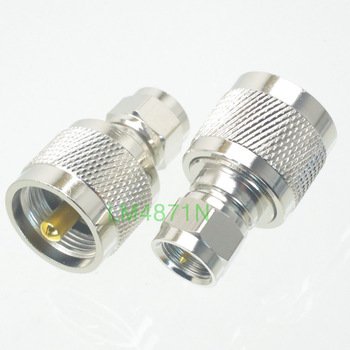Midpack
Give me a museum and I'll fill it. (Picasso) Give me a forum ...
I need connectors for a VHF antenna, so I can separate an RG-8X cable as needed. Every merchant I talk to tells me I need to buy PL-259 connectors with RG-8X adapters, and solder the tips (at a minimum).
Like everyone, I've had CATV/Satellite/data cables in use for decades, at my home they're mostly RG-6U, with simple screw/press/crimp on F connectors and a bare center wire. Techs install them in seconds. They seem to work just fine.
I realize there are differences in the ohms, losses, center conductor, dielectric, shielding etc. between RG-6U vs RG-8X but they are not wildly different OD's. In fact the RG-8X is slightly smaller OD than RG-6U
So why do I need to use big, honkin PL-259's for RG-8X, they are HUGE by comparison to F connectors. I couldn't find a side by side (scale) picture, but I did find a PL-259>F adapter, which shows the relative diameter/size (your CATV and internet cable connectors would fit on the small end of these adapters, to give you an idea of the relative size of a PL-259).
Is there a smaller connector I can use for an RG-8X connection, or is there some good reason I need to use big, honkin' PL-259's? I sure hate to drill that great big hole to pass a PL-259 through if there's a smaller connector that will work just as well.
Obviously sparky stuff is not my forte, I know there are some strong electrical types here. TIA.
Like everyone, I've had CATV/Satellite/data cables in use for decades, at my home they're mostly RG-6U, with simple screw/press/crimp on F connectors and a bare center wire. Techs install them in seconds. They seem to work just fine.
I realize there are differences in the ohms, losses, center conductor, dielectric, shielding etc. between RG-6U vs RG-8X but they are not wildly different OD's. In fact the RG-8X is slightly smaller OD than RG-6U
So why do I need to use big, honkin PL-259's for RG-8X, they are HUGE by comparison to F connectors. I couldn't find a side by side (scale) picture, but I did find a PL-259>F adapter, which shows the relative diameter/size (your CATV and internet cable connectors would fit on the small end of these adapters, to give you an idea of the relative size of a PL-259).
Is there a smaller connector I can use for an RG-8X connection, or is there some good reason I need to use big, honkin' PL-259's? I sure hate to drill that great big hole to pass a PL-259 through if there's a smaller connector that will work just as well.
Obviously sparky stuff is not my forte, I know there are some strong electrical types here. TIA.
Attachments
Last edited:

